How Do Doctors Test a Baby’s Hearing?
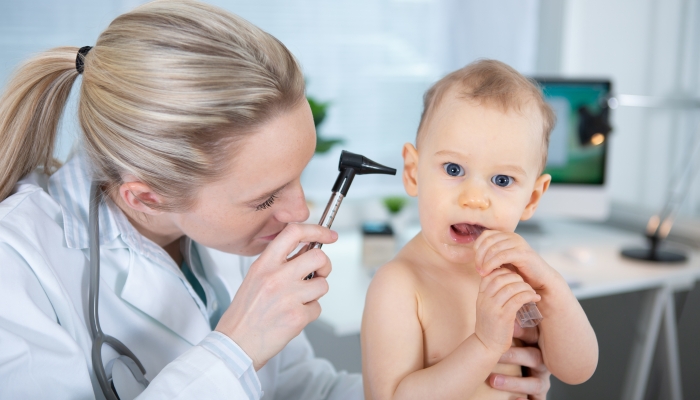
- A baby’s hearing screening is relatively simple and is important to repeat at different points throughout childhood.
- Symptoms of hearing loss should be promptly reported to your child’s pediatrician.
- Intervention services are available for children who are born deaf or are developing hearing loss.
Though it is rare, babies can be born with a detectable level of hearing loss. A baby’s hearing loss can occur from a variety of conditions, some of which can damage the hearing nerve. According to the National Institute on Deafness and Other Communication Disorders (NIDCD), only 0.2 to 0.3% of babies are born with congenital hearing loss.
Because the most critical time for children to learn language is in the first three years of life, it’s very important to correctly identify babies who have affected hearing.
The CDC recommends that the best way to identify childhood hearing loss is to screen newborns through a universal hearing screening process.
Fortunately, testing a baby’s hearing may seem more complicated than it really is! Screening newborns for hearing loss is probably one of the easiest tests your baby will ever experience.
Baby Hearing Test: What Parents Need to Know
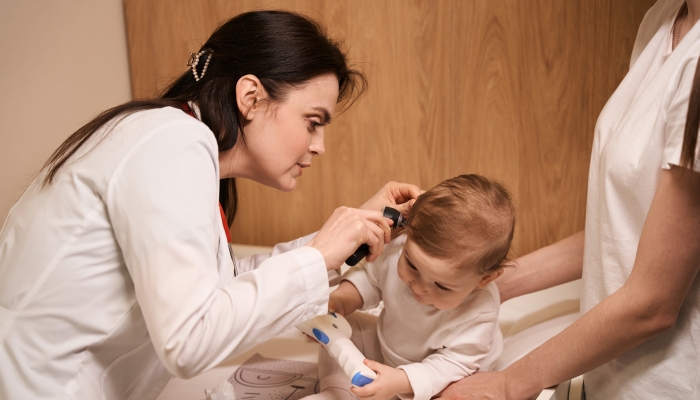
A hearing screening may sound vague or confusing, but it is actually a simple process to determine typical hearing patterns in a newborn.
What Is a Baby Hearing Test?
Newborn hearing screening, or early hearing detection, is a simple method of passing soft sounds or clicks through your baby’s ear and measuring the brain’s response. Referred to as an automated auditory brainstem response (ABR), the test is easy, painless, and generally over after just a few minutes.
Most babies sleep through their hearing screening, which is helpful in providing accurate results since movement can interfere with the recording. As referenced in the American Family Physician Journal11. Bush, Jennifer S.. AAP Issues Screening Recommendations to Identify Hearing Loss in Children. American Family Physician Journal. 2003;67(11), 2409-2413. https://www.aafp.org/pubs/afp/issues/2003/0601/p2409.html, the American Academy of Pediatrics (AAP) recommends that babies be asleep or sedated for their hearing exam:
“The automated auditory brainstem response (ABR) is one objective means of evaluating hearing. It is currently used in many newborn-screening programs, but can be used in children of any age. The instrument is automated and provides a pass-fail report; no test interpretation by an audiologist is required. Because motion artifact interferes with test results, ABR is best performed in infants and children who are sleeping or, if necessary, sedated.”
Why Is It Important to Have Your Baby’s Hearing Tested?
Because the ability to hear is closely tied to language development, spoken language skills, and social-emotional development, it is extremely important to screen for hearing loss at different stages of your child’s life.
Hearing screening should ideally occur before your baby is discharged from the hospital or birthing center or as soon as possible before one month of age.
Types of Newborn Hearing Screens
Did you know there are different screening methods to determine what your baby hears?
Some of the most common newborn screening tests include:
- Automated Auditory Brainstem Response or Auditory Brainstem Response (AABR). This screening method measures responses from the inner ear as well as the auditory brainstem, testing as sound travels up to the brain. Small earphones are placed over the baby’s ears, while sticker electrodes placed around the ears or her head measure whether there is a response from the baby’s ear and brainstem. If your baby passes this screen, a response from both areas will be noted.
- Auditory Evoked Response (AER). According to a study published in 2015 in The Open Biomedical Engineering Journal22. Paulraj MP, Subramaniam K, Yaccob SB, Adom AH, Hema CR.. Auditory evoked potential response and hearing loss: a review. Open Biomedical Engineering Journal. 2015;9, 17-24. https://doi.org/10.2174/1874120701509010017 by Paulraj and colleagues, a baby’s hearing test using this method involves the use of an electroencephalogram (EEG). The authors report that “EEG-based hearing threshold level determination is most suitable for babies and persons who lack verbal communication and behavioral response to sound stimulation. AER reflects the auditory ability of an individual.”
- Otoacoustic Emissions (OAE). This diagnostic test measures part of the inner ear’s response to sound and is appropriate for babies and children. Soft conductor tips placed in the baby’s ear canal emit quiet clicks while a computer records a soft echo from the ear. If there is notable hearing loss, no echo or a reduced echo from the ear will be noted.
As your child grows, different methods of hearing tests may be used to determine normal hearing development.
How to Tell if a Baby Needs a Hearing Test
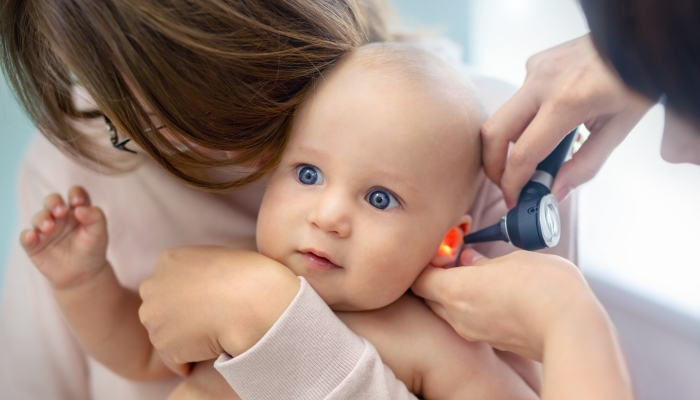
According to the American Academy of Pediatrics (AAP), “the goal is for all babies to have a newborn hearing screening by one month of age, ideally before they go home from the hospital; identified by three months of age and enrolled in early intervention or treatment, if identified as deaf or hard of hearing, by six months of age.”
But how can you tell if your new baby is experiencing hearing loss? The AAP and The American Academy of Audiology recommend seeking a physician’s advice if your child:
- Has a family history or risk factors of childhood hearing loss.
- Had a neonatal intensive care unit (NICU) stay of longer than five days.
- Received intravenous (IV) administration of antibiotics known to cause damage to hearing and/or balance organs.
- Was exposed to infections that occurred before or after birth, such as herpes, rubella, syphilis, toxoplasmosis, or viral or bacterial meningitis.
- Experienced head injury or birth trauma, resulting in damage to the auditory nerve.
- Doesn’t startle at loud noises by one month or turn toward sounds by three to four months of age.
- Doesn’t notice you until he sees you.
- Concentrates on vibrating noises more than other types of sounds.
- Doesn’t seem to enjoy being read to.
- Is slow to begin talking, hard to understand, or doesn’t say single words such as “dada” or “mama” by 12 to 15 months of age.
- Doesn’t always respond when called, especially from another room.
- Seems to hear some sounds but not others. (Some hearing loss affects only high-pitched sounds; some children have hearing loss in only one ear.)
- Has trouble holding their head steady or is slow to sit or walk unsupported. (In some children with hearing loss, the part of the inner ear that provides information about balance and movement of the head is also damaged.)
- Wants the TV volume louder than other members of the family.
Hearing loss can develop over time, even if your baby initially passed their newborn hearing test: It is recommended that children have their hearing screened at different points as they grow.
Who Performs a Baby Hearing Test?
A newborn hearing screening is typically done before your baby is able to be discharged from the hospital or birthing center and can be performed by a staff member.
If your baby does not pass their hearing screen, the hospital or your baby’s pediatrician may recommend additional testing or follow-up testing from a hearing specialist at an audiologist’s office. A healthcare professional at this office will perform more hearing testing to determine if your baby has hearing loss.
Your baby’s doctor may also recommend a visit to an ear/nose/throat doctor (otorhinolaryngologist) for more tests to evaluate hearing loss, particularly if the problem is thought to be congenital or due to structural differences in the ear.
How is a Baby Hearing Test Done?
You might remember having a hearing screening yourself at a doctor’s office and having to raise a hand or signal when hearing the sound in each ear.
Hearing testing for a newborn generally involves measuring the ear or brain’s response to a soft sound or stimulus. This screen can be done by placing small earphones on the baby’s head and transmitting sound through the headphones or by placing soft conductor tips into the baby’s ear canal and transmitting a signal to measure otoacoustic emissions.
These tests are usually brief and painless, with most babies sleeping through the hearing screening.
What Happens After a Baby Hearing Test?
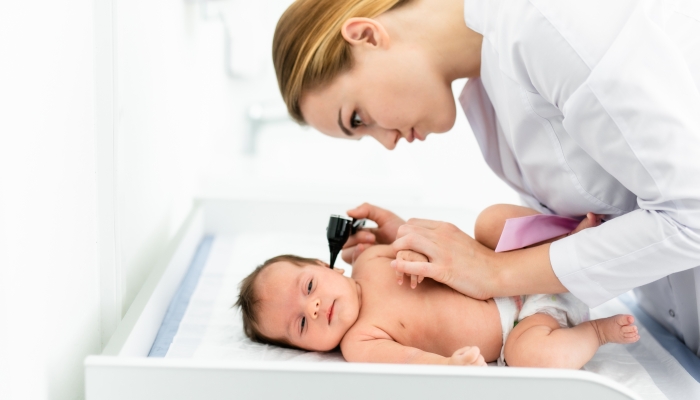
If your baby passes their hearing test, they are considered to have normal hearing and will continue to have a screening test at different points throughout their childhood.
My Baby Didn’t Pass The Hearing Screening: Why?
It can be easy to fear that your child is deaf when you receive word that your baby didn’t pass their hearing test.
However, there are factors that can impact your baby’s ability to pass their hearing screening. These include situations such as:
- Fluid in the middle ear.
- Leftover vernix33. Singh G, Archana G.. Unraveling the mystery of vernix caseosa. Indian Journal of Dermatology. 2008;53(2), 54-60. https://doi.org/10.4103/0019-5154.41645.
- Baby is fussy or crying during the hearing test.
- Excess ambient noise while receiving the hearing screening.
If your baby continues to not pass the hearing test despite repeated attempts, your baby may need further testing or diagnostic tests like visual reinforcement audiometry44. Sabo DL.. The audiologic assessment of the young pediatric patient: the clinic. Trends in Amplification. 1999;4(2), 51-60. https://doi.org/10.1177/108471389900400205 in order to evaluate for hearing loss and gain a better understanding of your baby’s ears.
Intervention Options After Your Baby Hearing Test
If your baby has been diagnosed with hearing loss of any sort, you’ll want to start looking into intervention services as soon as possible to reduce any developmental delay in your baby.
As you work to identify options with your child’s healthcare team, consider such ideas as:
Speech-Language Therapy
Working with a speech-language pathologist (SLP) can help identify valuable strategies for learning to communicate with your little one experiencing hearing loss. Your baby is most likely to show spoken language development at a rate similar to a baby without hearing loss when diagnosed early.
Sign Language
Sign language is a valuable tool to enhance communication with pre-verbal and non-verbal children of all ages.
Assistive Technology
Many devices, such as a frequency modulation (FM) system, are available to help children who lose hearing abilities maximize sounds heard or communicate with hearing individuals.
Devices
According to the American Speech-Language-Hearing Association, assistive hearing devices like hearing aids can be used successfully for babies and very young children. Professionals at the American Academy of Audiology report that cochlear implants can also be used in children and that “cochlear implants are an option when benefit from hearing aids is limited and should not be viewed as a last resort.”
A child’s hearing ability can change over time. Because hearing loss in a young child can significantly impact their development and communication skills, performing regular screening tests allows for early intervention services if a child demonstrates hearing loss.
References
- Bush, Jennifer S. (2003). AAP Issues Screening Recommendations to Identify Hearing Loss in Children. American Family Physician Journal. 67(11), 2409-2413. https://www.aafp.org/pubs/afp/issues/2003/0601/p2409.html
- Paulraj MP, Subramaniam K, Yaccob SB, Adom AH, Hema CR. (2015). Auditory evoked potential response and hearing loss: a review. Open Biomedical Engineering Journal. 9, 17-24. https://doi.org/10.2174/1874120701509010017
- Singh G, Archana G. (2008). Unraveling the mystery of vernix caseosa. Indian Journal of Dermatology. 53(2), 54-60. https://doi.org/10.4103/0019-5154.41645
- Sabo DL. (1999). The audiologic assessment of the young pediatric patient: the clinic. Trends in Amplification. 4(2), 51-60. https://doi.org/10.1177/108471389900400205
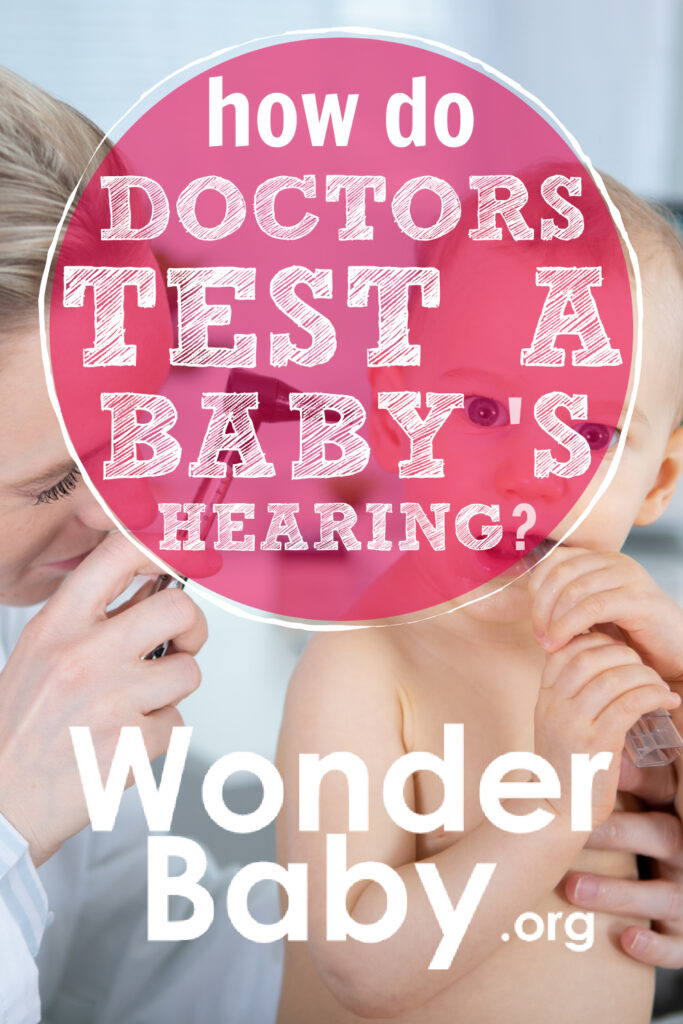
The information WonderBaby provides is not intended to be, and does not constitute, medical or other health advice or diagnosis and should not be used as such. Always consult with a qualified medical professional about your specific circumstances.
Related Posts

Eye Conditions and Syndromes, Visual Impairment
Neuralink Announces Plans to Restore Sight to the Blind with Brain Chip
Elon Musk’s company Neuralink has announced plans to begin human trials of its new “Blindsight” brain chip by the end of 2025.

Special Needs
5 Spring Cleaning Tips for Families of Children with Disabilities
Spring cleaning is an opportunity to create a more accessible, organized, and supportive space for your child with disabilities. Declutter, deep clean, and refresh!

Visual Impairment
The Gift of Understanding: How a Young Child Helps His Blind Father Navigate Life
When a parent is blind, it’s natural for people to wonder how their sighted child will adapt. Will they struggle to understand their parent’s needs? Will they feel burdened by...